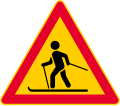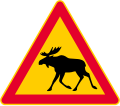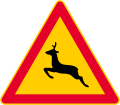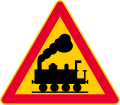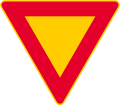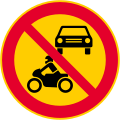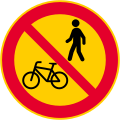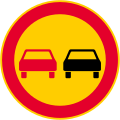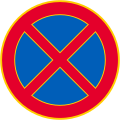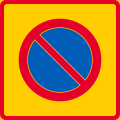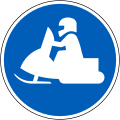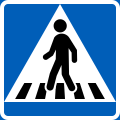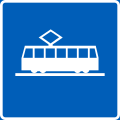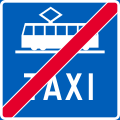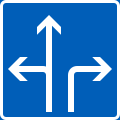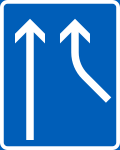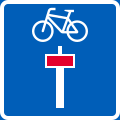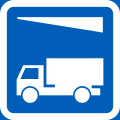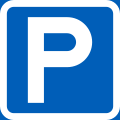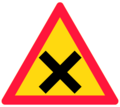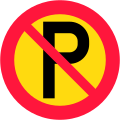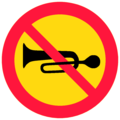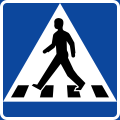Top Qs
Timeline
Chat
Perspective
Road signs in Finland
From Wikipedia, the free encyclopedia
Remove ads
Road signs in Finland were formerly regulated in the Road Traffic Regulation (5.3.1982/182) (Finnish: Tieliikenneasetus),[1] but now are currently regulated in the Road Traffic Act (8.5.2020/360) (Finnish: Tieliikennelaki).[2]
This article needs to be updated. The reason given is: Please check completeness. (June 2020) |


Most signs are based on pictograms, except signs like the prohibition-sign for stop at customs and the sign indicating a taxi rank. If the sign includes text, the text is written in Finnish or Swedish, except the stop sign and taxi signs which are written in English (some taxi signs are written TAKSI in Finnish). Many roads and places in Finland have Finnish and Swedish names, so both are marked on the traffic signs. This is common in the Swedish-speaking areas on the southern and western coasts, whereas in the inland Swedish names are far less common. In northern Lapland there are also traffic signs in the Northern Sámi, Skolt Sámi and Inari Sámi languages.
At many unregulated intersections the practice is to yield to traffic on-coming from the right, unless there is a "yield" or "give way" sign posted for the right on-coming traffic. This can be a problem on some streets since these signs are not always visible to traffic that does not have to yield. Therefore, unless a driver is experienced with the area and its signs, they are expected to give way to the right at an intersection, even if the road they are on appears to be the priority road.
Finnish road signs depict gender-neutral people with stylized silhouettes since 2020; between 1982 and 2020, the designs were realistic, as was common in most Nordic countries at the time. Since the last legal reform, most of the pictograms and arrows are identical to their German counterparts, whereas the new diagrams for people are similar to the Danish models.
In addition, Åland, an autonomous region of Finland, has some in Swedish-style signs and all are written in the Swedish language.
Finland signed the Vienna Convention on Road Signs and Signals on December 16, 1969 and ratified it on April 1, 1985.[3]
Remove ads
Major differences between Finnish and general European signs
Whereas European signs usually have white background on warning and prohibition signs, Finnish signs have a yellow/orange colour. This is for the purpose of enhancing the visibility of the sign during the winter, as white signs would be hard to see in the snow. Prohibition signs displaying a symbol other than a numeric value have a diagonal red line across them. Prohibition signs in Iceland and Sweden are similar in this respect. In most European countries, however, such signs do not usually include a red line.
Remove ads
Warning signs
Summarize
Perspective
Warning signs are triangular, but in contrast to those of most other states using triangular warning signs, Finnish signs have yellow backgrounds, rather than white.
- Road narrows on both sides
- Uneven road ahead
- Pedestrians
- Animals (Elk)
- Animals (Reindeer)
- Animals (Deer)
- Intersection, equal (rightside has the priority)
- Traffic signals
- Tramway
- Level crossing without gates
- Level crossing with gates
- Distance to level crossing
- Distance to level crossing
- Distance to level crossing
- Single track level crossing
- Multitrack level crossing
- Low-flying aircraft
- Other dangers
Remove ads
Priority signs
- Priority road
- End of priority road
- Give way
- Stop
- Cycle crossing
Prohibitory signs
Summarize
Perspective
Prohibitory signs are round with yellow backgrounds and red borders, except the no parking and no standing signs that have a blue background instead of yellow.
- Closed to all vehicles in both directions
- No vehicles carrying dangerous goods
- No buses
- No cycles or mopeds
- No entry
- No vehicles exceeding [...] tonnes laden weight
- Speed limit
- Speed limit zone
- Loading zone
- Loading zone
- Passing without stopping prohibited (customs control)
- Passing without stopping prohibited (customs control)
- Passing without stopping prohibited (customs control)
- Vehicles equipped with studded tyres prohibited
Remove ads
Mandatory signs
Summarize
Perspective
Mandatory signs are always round blue signs with white border.
- Direction to be followed (proceed in any direction)
- Minimum speed limit
- End of minimum speed limit
Remove ads
Special regulation signs
- Park and ride
- Park and ride
- Park and ride
- Park and ride
- Park and ride
- Parking
- Placing vehicles on a parking place
- Placing vehicles on a parking place
- Placing vehicles on a parking place
- Taxi station
- Bus lane (sign above the line)
- Bus and taxi lane (sign above the line)
- Tramway lane (sign above the line)
- Tramway and taxi lane (sign above the line)
- Cycle lane (sign above the line)
- Cycle lane (sign above the line)
- One-way traffic
- Motorway
- Tunnel
- End of built-up area
- Cycle street
- End of cycle street
Remove ads
Information signs
- Advance direction sign (type A)
- Advance direction sign (type B)
- Advisory sign for detour
- Detour
- Route to be followed (in order to turn left)
- Information on traffic lanes
- Information on traffic lanes
- Information on traffic lanes
- Advance direction sign (above the lane; type A)
- Advance direction sign (above the lane; type B)
- Exit sign (above the lane)
- Direction sign
- Exit sign
- Direction sign on private road
- Location sign
- Advance location sign
- Direction sign for light traffic (pedestrian and cycle traffic)
- Direction sign for detour
- Direction sign for detour
- Direction sign for local purposes
- Direction sign showing a motorway or road for motor vehicles
- Direction sign showing park-and-ride facilities
- No through road
- No through road
- Advisory speed
- Sign showing distances
- Place name (waterway)
- Road number (E-road; European route)
- Road number (primary road; main road, Class I; 1–39)
- Road number (secondary road; main road, Class II; 40–99)
- Road number (regional road; 100–999)
- Road number (ordinary road; connecting road; 1000–9999)
- Road number (ring road)
- Direction to the numbered road
- Airport
- Ferry
- Passenger terminal
- Cargo terminal
- Freight terminal
- Retail park
- Railway station
- Bus station
- City Centre symbol
- Itinerary for handicapped
- Emergency exit
- Direction to emergency exit
Remove ads
Service signs
- Information sign for services
- Information sign for services
- Advance information sign for services
- Location sign for tourist service
- Advance location sign for tourist service
- Radio station (frequency in MHz)
- Gasoline station (with compressed natural gas)
- Electric vehicle charging station
- Petrol station (with hydrogen)
- Cross-country skiing centre
Remove ads
Additional panels
- Sign applies [...] km in the direction of the arrow
- Camper van
- Snowmobiles
- Tractors
- Low-emission vehicles
- No entry for vehicles carrying dangerous goods of group A
- No entry for vehicles carrying dangerous goods of group B
- Tunnel class B
- Tunnel class C
- Tunnel class D
- Tunnel class E
- Charging space for electric vehicles
- Two-way path
- Additional panel with text "Occasionally foggy"
- Additional panel with text "Zone"
- Additional panel with text "General limit"
- Sharp Curve
Remove ads
Other signs
- General speed limits
- National border (Schengen area)
Retired signs (no longer used)
Summarize
Perspective
Below, signs are withdrawn or replaced with new diagrams of the same meaning.
Attention signs
- General attention (1937–1957)
- School (1937–1957)
Warning signs
- Winding road (1937–1974)
- Steep hill downwards (1982–1994)
- Steep hill upwards (1982–1994)
- High pavement edge (1982–1994)
- Weak shoulder (1982–1994)
- Pedestrian crossing (1969–1980s)
- Children (1957–1974)
- Crossroads (1937–1994)
- Tramway (1957–1982)
- Single track level crossing (1932–1974)
- Multitrack level crossing (1932–1974)
- Level crossing front (1932–1970s)
- Other dangers (1937–1994)
Priority signs
- Priority road (1939–1957)
- End of priority road (1939–1957)
- Give way (1937–1994)
- Stop (1957–1971)
Prohibitory signs
- Closed to all vehicles in both directions (1937–1994)
- No power-driven vehicles (1937–1957)
- No power-driven vehicles (1957–1982)
- No cars (1937–1957)
- No lorries (1957–1982)
- No motorcycles (1957–1982)
- No cycles (1957–1982)
- No pedestrians (1969–1982)
- No entry (1930–1937)
- No entry (1937–1995)
- No left turn (1957–1982)
- No right turn (1957–1982)
- No overtaking (1937–1957)
- Speed limit (1937–1969)
- End of speed limit (1957–1969)
- No stopping or parking (1937–1969)
- No parking (1930–1937)
- No parking (1937–1969)
- Taxi waiting zone (1982–1994)
- Taxi stopping zone (1982–1994)
- No horns (1937–1957)
- Alternate date parking zone (1982–1994)
- End of alternate date parking zone (1982–1994)
Mandatory signs
- Direction to be followed (turn right only) (1937–1957)
- Direction to be followed (turn right only) (1957–1974)
- Direction to be followed (turn left only) (1937–1957)
- Direction to be followed (turn left only) (1957–1974)
- Compulsory roundabout (1937–1957)
- Compulsory roundabout (1957–1982)
- Pass this side (right side) (1957–1974)
- Pass this side (left side) (1957–1974)
- Pass either side (1957–1974)
- Footpath (1937–1957)
- Footpath (1957–1974)
- Footpath (1974–1982)
- Cycleway (1937–1957)
- Cycleway (1957–1974)
Special regulation signs
- Pedestrian crossing (1957–1974)
- Pedestrian crossing (1974–1985)
- Parking (1937–1974)
- Passing place (on narrow roads) (1937–1974)
- Bus stop (local) (1957–1974)
- Bus stop (local) (1974–1994)
- Bus stop (long-distance) (1957–1974)
- Bus stop (long-distance) (1974–1994)
- Tramway stop (1957–1974)
- Tramway stop (1974–1982)
- Taxi station (1957–1974)
- Taxi station (1974–1994)
- Bus lane (1972–1994)
- End of bus lane (1972–1994)
- One-way street (1957–1982)
- Motorway (1962–1982)
- End of motorway (1962–1982)
Information signs
- Place name (1937-1994)
- Lane preselection (1957–1982)
- Lane preselection (1957–1982)
- Lane preselection (1957–1982)
- Road number (secondary road; main road, Class II; 40–99) (1937-1994)
- Road number (regional road; 100–999) (1960s–1994)
- Direction sign (1937–1960s)
- Direction sign showing highways (1937–1960s)
- Direction sign showing main roads (1937–1960s)
- Direction sign on villages or municipal roads (1937–1960s)
- Direction sign on private roads (1937–1960s)
- Direction sign on through roads for local purposes (1937–1960s)
- Advance direction sign (1957–1960s)
- Information on traffic lanes (1969–1982)
- Creep lane (1974–1982)
- Direction sign for detour (1970s–1994)
- Advisory sign for detour (1970s–1994)
- Detour (1970s–1982)
- Detour (1982–1994)
- Direction to the numbered road (1937-1994)
- Cycle route (1974–1982)
- Pedestrian route (1974–1982)
Service signs
- Tourist route (1995–2007)
- Information point (1969–2007)
- Telephone (1957–1982)
- Telephone (1982–2007)
- Emergency telephone (1978–2007)
- First-aid (1957–1978)
- Tourist attraction (1969–2007)
- Cottage accommodation (1982–2007)
- Swimming place (1969–2007)
- Fishing place (1982–2007)
- Ski lift (1982–2007)
- Direct sale (1994–2007)
Remove ads
Road signs in Åland
Warning signs
- Children
- Crossroads without priority
- Crossroads with priority
- Traffic lights ahead
- V26 Logging route
- V29 Other danger
Priority signs
- Fö1 Give way
- Fö2 Stop
- Fö3 Priority road
- Fö4 End of priority road
- Fö5 Priority to oncoming traffic
- Fö6 Priority over oncoming traffic
Prohibitory signs
- Vehicular traffic prohibited
- No entry
- Stop at customs
- No stopping
- No parking
- No parking on odd days
- No parking on even days
- F30 Speed limit
- F31 End of speed limit
Other signs
- A3 Home zone
- A4 End of home zone
- A5 Pedestrian zone
- A6 Pedestrian zone ends
- A11 Pedestrian crossing
- Tourist Area
- Postal Road
- Detour information
- Midway sign bike
References
External links
Wikiwand - on
Seamless Wikipedia browsing. On steroids.
Remove ads






















